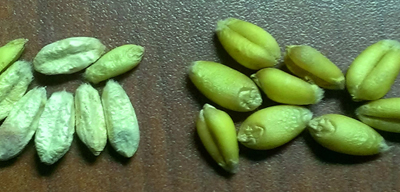Preserving grain quality when harvesting the 2015 wheat crop
Fusarium head scab is a disease that is readily found in Michigan wheat this season. Steps to reduce the risk of delivery discounts are listed here.

Harvest time is here for wheat growers. As in many seasons, the single biggest concern relates to a disease called Fusarium head scab. While not considered a severe outbreak this 2015 season, the symptoms of this fungal disease – scabby heads – are evident in all fields. Certainly, the disease is severe enough in some fields to justify concern over a naturally occurring mycotoxin called DON or vomitoxin, which is a by-product of the pathogen. Most loads will be tested for DON upon delivery and discounts will be imposed where levels are overly high.
The number of scabby heads in a field can be an indicator of the amount of DON the wheat may contain. However, this sometimes leads to an underestimation of DON levels as infections that may occur or spread within the head late in the grain-fill period may not be visually evident. Furthermore, sometimes weather can be favorable for DON development until the grain dries. As in past seasons, genetically susceptible varieties that were not treated with a fungicide soon after heading are more likely to experience the greatest levels of DON.
Michigan State University Extension recommends several measures growers can take where they suspect they may have high DON levels. The measures are directed at reducing the amount of shrunken, scabby kernels and chaff from the load as this is where the highest levels of DON are found.
- Maximize threshing efficiency by going through the machine to make appropriate adjustments. Operators would do well to revisit the operator manual or an equipment representative to assure optimal settings, particularly related to the concaves.
- Avoid overworking the combine as it will decrease threshing efficiency and, again, result in more chaff in the load. Growers should avoid the temptation to increase ground speed.
- Increase the combine’s fan speed beyond the default setting to help minimize light material (shrunken kernels and chaff) when entering a new field. If testing confirms low DON levels, return to normal fan speeds to avoid blowing out healthy kernels.
- Harvest and load areas of the field having greater scab symptoms separately. Unless a grower has scouted and knows differently, the grain from the field perimeter, especially along wooded fence rows and headlands, should be loaded, delivered and tested separately from the main field. High testing wheat to be stored on-farm should be segregated from low-test wheat if possible.
- Harvest each wheat field as soon as possible. This might mean starting when the grain is 16 to 22 percent moisture depending on variety and combine. Again, this measure can be relaxed somewhat once it is determined the field's DON levels are low.
- Dry grain as soon as possible as DON is thought to be able to develop in grain having moisture contents as low as 18 percent.

Fusarium often results in shrunken, “tombstone” kernels (left).
Apart from the threat of DON, all wheat varieties are subject to sprout damage, reported as “falling number,” which occurs when rainfall or high humidity adds moisture to the grain soon after maturity. As with high DON levels, some sprout damage can be avoided by harvesting the wheat crop as soon as the grain is sufficiently dry to thresh.



 Print
Print Email
Email



